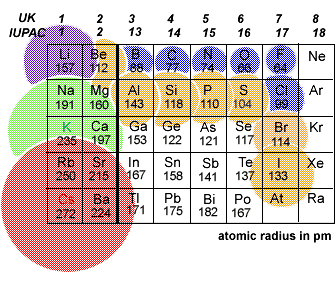

Landé estimated ionic radii by considering crystals in which the anion and cation have a large difference in size, such as LiI. The iodide ions nearly touch (but don't quite), indicating that Landé's assumption is fairly good. However, although X-ray crystallography gives the distance between ions, it doesn't indicate where the boundary is between those ions, so it doesn't directly give ionic radii.įront view of the unit cell of an LiI crystal, using Shannon's crystal data (Li + = 90 pm I − = 206 pm). Therefore, the distance between the Na + and Cl − ions is half of 564.02 pm, which is 282.01 pm. Each edge of the unit cell of sodium chloride may be considered to have the atoms arranged as Na +∙∙∙Cl −∙∙∙Na +, so the edge is twice the Na-Cl separation. For example, the length of each edge of the unit cell of sodium chloride is found to be 564.02 pm. The distance between two ions in an ionic crystal can be determined by X-ray crystallography, which gives the lengths of the sides of the unit cell of a crystal. This is because the greater covalent character of the bonds in AgCl and AgBr reduces the bond length and hence the apparent ionic radius of Ag +, an effect which is not present in the halides of the more electropositive sodium, nor in silver fluoride in which the fluoride ion is relatively unpolarizable. On the basis of the fluorides, one would say that Ag + is larger than Na +, but on the basis of the chlorides and bromides the opposite appears to be true. This is illustrated by the unit cell parameters for sodium and silver halides in the table. No bond is completely ionic, and some supposedly "ionic" compounds, especially of the transition metals, are particularly covalent in character. In general, ionic radius decreases with increasing positive charge and increases with increasing negative charge.Īn "anomalous" ionic radius in a crystal is often a sign of significant covalent character in the bonding. Ionic size (for the same ion) also increases with increasing coordination number, and an ion in a high-spin state will be larger than the same ion in a low-spin state. As with other types of atomic radius, ionic radii increase on descending a group. Nevertheless, ionic radius values are sufficiently transferable to allow periodic trends to be recognized. The ionic radius is not a fixed property of a given ion, but varies with coordination number, spin state and other parameters. Similarly, when an electron is added to an atom, forming an anion, the added electron increases the size of the electron cloud by interelectronic repulsion. When an atom loses an electron to form a cation, the other electrons are more attracted to the nucleus, and the radius of the ion gets smaller.

Ions may be larger or smaller than the neutral atom, depending on the ion's electric charge. The neutral atoms are colored gray, cations red, and anions blue. All compounds crystallize in the NaCl structure. Unit cell parameters (in pm, equal to two M–X bond lengths) for sodium and silver halides. The concept can be extended to solvated ions in liquid solutions taking into consideration the solvation shell. Ionic radii are typically given in units of either picometers (pm) or angstroms (Å), with 1 Å = 100 pm. Although neither atoms nor ions have sharp boundaries, they are treated as if they were hard spheres with radii such that the sum of ionic radii of the cation and anion gives the distance between the ions in a crystal lattice. Ionic radius, r ion, is the radius of a monatomic ion in an ionic crystal structure.


 0 kommentar(er)
0 kommentar(er)
